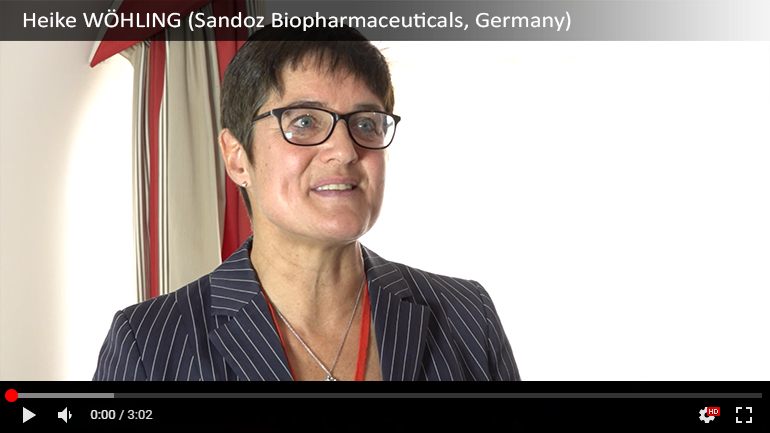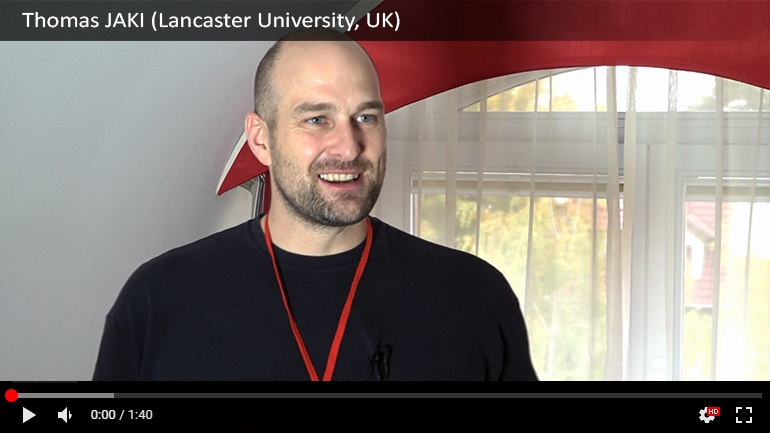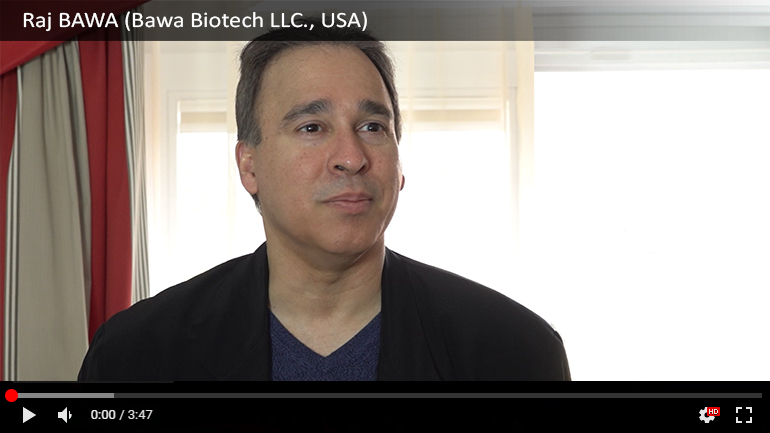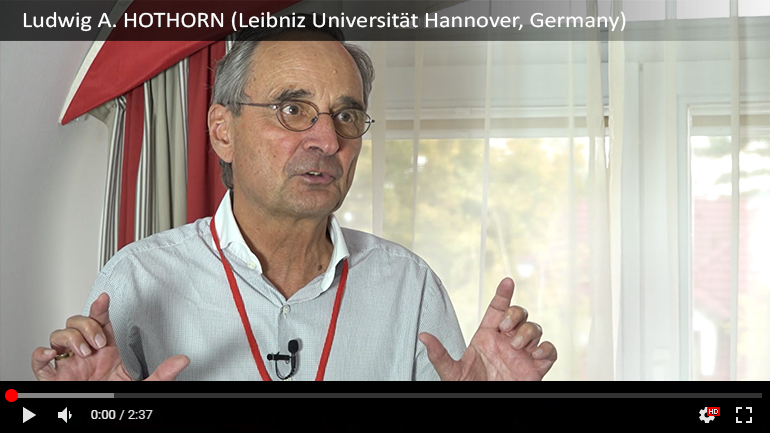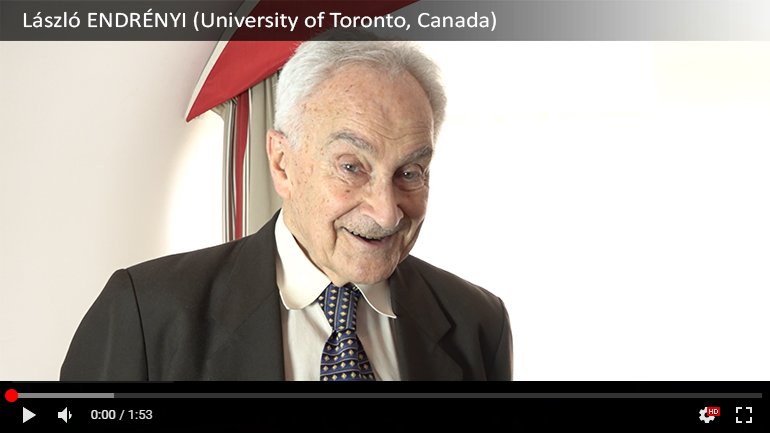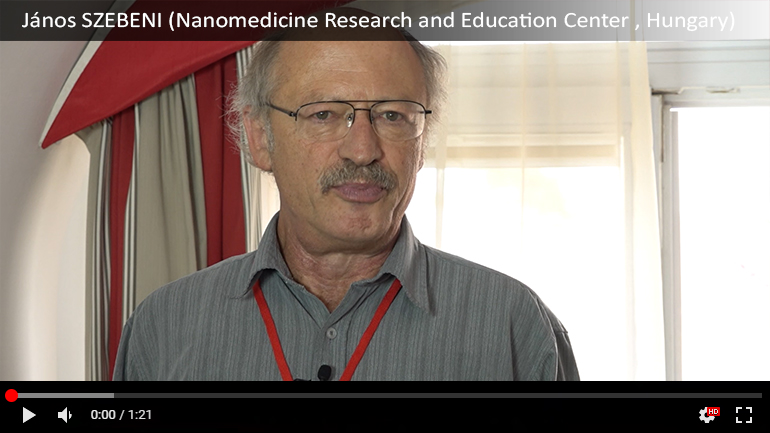VIDEO INTERVIEWS
Please watch these short video interviews with the key speakers of the 3rd Biosimilars Forum, summarizing their thoughts about the professional topic of the conference and sharing their experiences on this three-day event. We asked them about that
- Which are the most important challenges to overcome in the development of biosimilars in their field of research?
- Which are the area in which more guidance would needed?
- And we also asked them about the added values of this professional conference series in biosimilar development.
PHOTO GALLERY
CONFERENCE REPORT ARTICLE
Biosimilars & Nanosimilars: Chalenges and Future Perspectives – note from Annual Professional Forum at Accelsiors Ltd, Budapest
Overview: As a third in a series of events, this mini conference called Biosimilar Forum has already traditions. And because traditions are good to be kept, this year the same structure was followed as before: short course, invited speakers, presentations, round table. What was new this year was a third day which was entirely dedicated to nanosimilars. The three-day forum comprised 8 plenary sessions, with in total 16 speakers from around the world.
Day 1: PK short courses
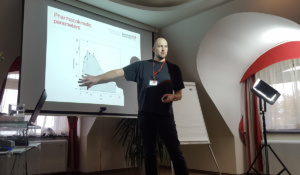 There were two short courses, both focusing on the problem of multiplicity in PK equivalence studies of biosimilars. Both pointing out that although there is a detailed guideline available for the univariate handling of PK parameters, the questions of multiplicity and the handling of missing data (mainly data below the limit of quantification) are still open. Solutions are complicated and a good guideline avoiding the cookbook style would be needed, but this may take years. When it arrived to real examples it was really interesting to see that the two different theoretical solutions proposed, based on different principles (Thomas Jaki’s and Philip Pallmann’s method based on joint confidence regions [for which an R package jocre was developed by Philip Pallmann], and Ludwig Hothorn’s method of a union-intersection test [UIT]) approach [more precisely UIT for testing multiple endpoints and multiple treatments, and intersection-union test for the two one-sided tests applied to each single parameter]) led to very similar results at the end.
There were two short courses, both focusing on the problem of multiplicity in PK equivalence studies of biosimilars. Both pointing out that although there is a detailed guideline available for the univariate handling of PK parameters, the questions of multiplicity and the handling of missing data (mainly data below the limit of quantification) are still open. Solutions are complicated and a good guideline avoiding the cookbook style would be needed, but this may take years. When it arrived to real examples it was really interesting to see that the two different theoretical solutions proposed, based on different principles (Thomas Jaki’s and Philip Pallmann’s method based on joint confidence regions [for which an R package jocre was developed by Philip Pallmann], and Ludwig Hothorn’s method of a union-intersection test [UIT]) approach [more precisely UIT for testing multiple endpoints and multiple treatments, and intersection-union test for the two one-sided tests applied to each single parameter]) led to very similar results at the end.
Day 2: Symposium – Clinical studies and regulatory questions
On the next day various problems related to biosimilar development were discussed. We got update on the bioequivalence of highly variable drugs (László Endrényi), and on development strategies of recently approved biosimilars in Europe (Johanna Mielke).
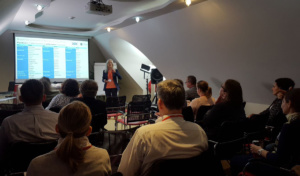 The regulatory keynote presentation was held by Andrea Laslop, and she gave some very interesting examples of difficult decision when the prescriptions of the guideline could not be kept entirely (e.g. confidence interval slightly exceeding the pre-defined margins which could be attributed to recent manufacturing changes of the originator, or slightly higher ADA incidence which did not translate into meaningful differences in clinical efficacy) but still a positive decision was made based on the totality of evidence. All these lead to the conclusion that the assessment of biosimilarity in critical quality attributes should be strengthened in the future (new statistical approaches to be defined), and tailoring of clinical evidence is needed. Gyurasics Ágnes presented some challenging issues in extrapolation of totality of evidence to pediatric indications in case of biosimilars.
The regulatory keynote presentation was held by Andrea Laslop, and she gave some very interesting examples of difficult decision when the prescriptions of the guideline could not be kept entirely (e.g. confidence interval slightly exceeding the pre-defined margins which could be attributed to recent manufacturing changes of the originator, or slightly higher ADA incidence which did not translate into meaningful differences in clinical efficacy) but still a positive decision was made based on the totality of evidence. All these lead to the conclusion that the assessment of biosimilarity in critical quality attributes should be strengthened in the future (new statistical approaches to be defined), and tailoring of clinical evidence is needed. Gyurasics Ágnes presented some challenging issues in extrapolation of totality of evidence to pediatric indications in case of biosimilars.
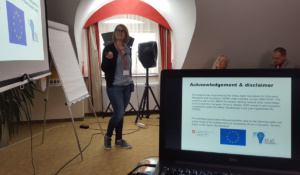 Continuing with a problem similar to the question raised by Andrea Laslop (i.e. how to take into account changes in the manufacturing changes of the originator), Heike Woehling analyzed cases where differences between immunogenicity results were partly attributable to the increased assay sensitivity. Common statistical tests do not take into account changes occurred in assay methodology, therefore estimates of the same parameter obtained at different time points are difficult to be compared. However, as Julia Singer pointed out, statistical methods to adjust the observed proportions for a known sensitivity and specificity are known (the first such method was published by Rogan and Gladen, 1978).
Continuing with a problem similar to the question raised by Andrea Laslop (i.e. how to take into account changes in the manufacturing changes of the originator), Heike Woehling analyzed cases where differences between immunogenicity results were partly attributable to the increased assay sensitivity. Common statistical tests do not take into account changes occurred in assay methodology, therefore estimates of the same parameter obtained at different time points are difficult to be compared. However, as Julia Singer pointed out, statistical methods to adjust the observed proportions for a known sensitivity and specificity are known (the first such method was published by Rogan and Gladen, 1978).
Although in different ways, all the presentations addressed somehow the question of what the future may/might bring to us. For instance, Johanna Mielke presented a hybrid Bayesian-frequentist statistical method to incorporate historical information on the reference product in clinical studies to assess biosimilarity. Emmanuelle Vincent shared her experience about the opportunities and limitations of a blinded sample size reassessment in some clinical studies. In the future the role of PD markers is expected to increase, and skipping clinical efficacy trials in the development of biosimilars will be chosen more and more often.
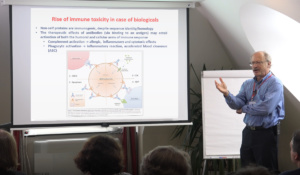 As a kind of preambulum to the third day of the forum which was dedicated to nanosimilars, János Szebeni delivered a presentation on animal models of immunogenicity and immune toxico-equivalence testing of nano-biopharmaceuticals.
As a kind of preambulum to the third day of the forum which was dedicated to nanosimilars, János Szebeni delivered a presentation on animal models of immunogenicity and immune toxico-equivalence testing of nano-biopharmaceuticals.
In the closing part of the second day there was an animated panel discussion led by Helmut Schuetz. Various topics were raised, here we mention only some of them: the inadequacy of the simple two-by-two cross-over design to separate different effects like period, sequence, carry-over; the criterion of equivalence in mean is required which later might be incorrectly interpreted as equivalence in distribution.
Day 3: Seminars in nanosimilars
As a very interesting novelty in this year’s programme, the 3rd-day agenda consisted of professional Seminar sessions dedicated to the nanodrug development topic with the participation of invited expert lecturers from the field of nanotechnology-formulated drug research.
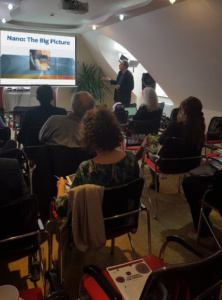 In the morning session, Raj Bawa (Founding Director of American Society for Nanomedicine) delivered a 2-part seminar about the current perspectives in the era of biosimilars and nanosimilars. He gave a thorough overview of this topic, touching the current challenges in drug R&D in the fields of biologics, nanomedicine, bio- and nanosimilars, pointing out the technological as well as the market trends and business aspects, covering the topics of the evolving regulations, patenting and future development opportunities. Translational challenge in medicine at nanoscale has been presented, as well as the whole translation process including all steps from basic research toward drug registration. Basics related to biological products has been described, including but not limited to explanations of their complexity level along with numerous examples from practice. Finally, Dr. Bawa gave a detailed description on nanotechnology and a detailed overview for the fields of targeted nanomedicine, bio- and nanosimilar drug development. Specifically related to this topic – different material types, route of administration, as well as various factors influencing safety and efficiency of the nanodrugs were extensively discussed.
In the morning session, Raj Bawa (Founding Director of American Society for Nanomedicine) delivered a 2-part seminar about the current perspectives in the era of biosimilars and nanosimilars. He gave a thorough overview of this topic, touching the current challenges in drug R&D in the fields of biologics, nanomedicine, bio- and nanosimilars, pointing out the technological as well as the market trends and business aspects, covering the topics of the evolving regulations, patenting and future development opportunities. Translational challenge in medicine at nanoscale has been presented, as well as the whole translation process including all steps from basic research toward drug registration. Basics related to biological products has been described, including but not limited to explanations of their complexity level along with numerous examples from practice. Finally, Dr. Bawa gave a detailed description on nanotechnology and a detailed overview for the fields of targeted nanomedicine, bio- and nanosimilar drug development. Specifically related to this topic – different material types, route of administration, as well as various factors influencing safety and efficiency of the nanodrugs were extensively discussed.
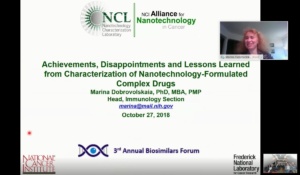 In the following session of the forum, Marina Dobrovolskaia (Head of the Immunology Section at the Nanotechnology Characterization Laboratory) showcased her online presentation about the immunological characterization of nanotechnology-formulated drugs and she gave deep insight into the achievements, disappointments and lessons learned over past decade from the developments in the area of this highly complex drugs. During the presentation Dr. Dobrovolskaia pointed out the importance of endotoxin screening for preventing erroneous data and corresponding wrong conclusions. Potential problems with immunogenicity of protein based APIs or targeting ligands due to the endotoxin presence were commented. Challenges related to the translation of therapeutic nucleic acids from bench to bedside were raised, including the importance of immune-mediated toxicities causing product development discontinuation. The importance of understanding mechanism of toxicity for the creation of safe and efficient complex drug systems was also discussed during this session.
In the following session of the forum, Marina Dobrovolskaia (Head of the Immunology Section at the Nanotechnology Characterization Laboratory) showcased her online presentation about the immunological characterization of nanotechnology-formulated drugs and she gave deep insight into the achievements, disappointments and lessons learned over past decade from the developments in the area of this highly complex drugs. During the presentation Dr. Dobrovolskaia pointed out the importance of endotoxin screening for preventing erroneous data and corresponding wrong conclusions. Potential problems with immunogenicity of protein based APIs or targeting ligands due to the endotoxin presence were commented. Challenges related to the translation of therapeutic nucleic acids from bench to bedside were raised, including the importance of immune-mediated toxicities causing product development discontinuation. The importance of understanding mechanism of toxicity for the creation of safe and efficient complex drug systems was also discussed during this session.
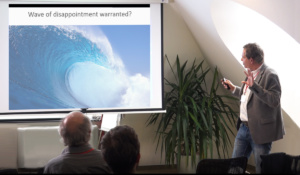 The nanomedicine part of the event was further strengthened by Gert Storm, who presented an interesting overview about the current status and future opportunities in the use of nanoparticles for drug targeting. Opportunities to achieve increased therapeutic index through targeted nanomedicines able to favourably change the efficacy/safety balance were discussed. Prof Storm shared his experience related to major limitation of IV nanoparticulate drug targeting has been presented in dynamic and comprehensive way. Special attention has been draw on extravasation through ‘leaky’ vasculature – EPR effect which can, by improving accessibility, positively affect drug efficacy. The use of EPR passive drug targeting to tumor was also presented through practical examples.
The nanomedicine part of the event was further strengthened by Gert Storm, who presented an interesting overview about the current status and future opportunities in the use of nanoparticles for drug targeting. Opportunities to achieve increased therapeutic index through targeted nanomedicines able to favourably change the efficacy/safety balance were discussed. Prof Storm shared his experience related to major limitation of IV nanoparticulate drug targeting has been presented in dynamic and comprehensive way. Special attention has been draw on extravasation through ‘leaky’ vasculature – EPR effect which can, by improving accessibility, positively affect drug efficacy. The use of EPR passive drug targeting to tumor was also presented through practical examples.
In the final discussion section of the conference, the participants had a highly constructive conversation about the future perspectives of bio- and nanosimilars, recent developments, as well as regulatory challenges in the field of innovative drug development.
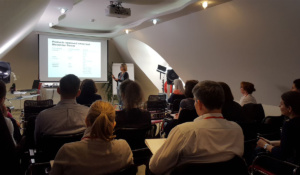 The audience of the Forum comprised various professions like regulators, medical scientists, clinical researchers, experienced biostatisticians and other representatives of the pharmaceutical developer companies. The size (around 100 participants in total) and the cozy atmosphere of this event enables not only rigorous methodological presentations but also sincere and friendly discussions as well as professional networking. All the participants agreed that – like the previous two forums hosted by Accelsiors – this was a very fruitful meeting, helping to share problems, to crystallize ideas, and it might contribute to the development of new guidelines and changing the old ones if needed.
The audience of the Forum comprised various professions like regulators, medical scientists, clinical researchers, experienced biostatisticians and other representatives of the pharmaceutical developer companies. The size (around 100 participants in total) and the cozy atmosphere of this event enables not only rigorous methodological presentations but also sincere and friendly discussions as well as professional networking. All the participants agreed that – like the previous two forums hosted by Accelsiors – this was a very fruitful meeting, helping to share problems, to crystallize ideas, and it might contribute to the development of new guidelines and changing the old ones if needed.
 25 OCT, 2018 | 1st DAY: PK COURSES
25 OCT, 2018 | 1st DAY: PK COURSES
Morning Course Session:
Uni- and multivariate Bioequivalence of PK parameters
|
Lecturers of the Morning Course Session:  Thomas JAKI Thomas JAKIProfessor of Statistics, Medical and Pharmaceutical Statistics Research Unit, Department of Mathematics and Statistics, Lancaster University, UK |
 Philip PALLMANN Philip PALLMANN Deputy Director Research Design and Conduct Service and Research Fellow, Cardiff University, UK |
Afternoon Course Session:
Statistical aspects of equivalence testing for biosimilar studies: multiple, differently-scaled endpoints
 The course is lectured by: The course is lectured by:Ludwig A. HOTHORN, Professor of Biostatistics at Leibniz Universität Hannover, Faculty of Natural Sciences, Germany |
 26 OCT, 2018 | 2nd DAY SYMPOSIUM AND ROUND TABLE: Clinical Research and Regulatory
26 OCT, 2018 | 2nd DAY SYMPOSIUM AND ROUND TABLE: Clinical Research and Regulatory
An update on development strategies of recently approved biosimilars in Europe
|
|
Scientific Keynote Presentation:
Bioequivalence of highly variable drug products – an update
 László ENDRÉNYI, László ENDRÉNYI,Professor Emeritus of Pharmacology and Biostatistics, University of Toronto; Former President of Canadian Society for Pharmaceutical Scientists |
 Co-author: László TÓTHFALUSI, Co-author: László TÓTHFALUSI,Associate Professor, Faculty of Pharmacology, Semmelweis Medical University |
Challenging issues in extrapolation of totality of evidence to pediatric indications in case of biosimilars
 Ágnes GYURASICS, Ágnes GYURASICS,Hungarian member of EMA Committee for Human Medicinal Products (CHMP), and EMA Paediatric Committee (PDCO); Unit Head at National Institute of Pharmacy and Nutrition, Hungary |
Regulatory Keynote Presentation:
The biosimilar concept revisited – is there a need for change?
 Andrea LASLOP, Andrea LASLOP,Unit Head, Austrian Medicines and Medical Devices Agency |
Opportunities and limitations of a blinded sample size reassessment in biosimilars development
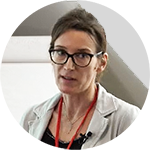 Emmanuelle VINCENT, Emmanuelle VINCENT,Head of Biostatistics and Data Management, Fresenius-Kabi |
Incorporating historical information in biosimilar trials: Challenges and a hybrid Bayesian‐frequentist approach
 Johanna MIELKE, Johanna MIELKE,Early Stage Research Fellow, IDEAS Innovative Training Network, Germany |
How the increase of assay sensitivity influences the immunogenicity
 Heike WÖHLING, Heike WÖHLING,Director Biostatistics for Biostatistics Biosimilars, Analytics group, Novartis, Germany |
Animal models of immunogenicity and immune toxico-equivalence testing of nano-biopharmaceuticals
 János SZEBENI, János SZEBENI,Director of the Nanomedicine Research and Education Center, Semmelweis Medical University, Budapest, Professor at University of Miskolc, Dep. of Nanobiotechnology and the Regenerative Medicine, Institute of Theoretical Medicine |
 27 OCT, 2018 | 3rd DAY SEMINAR in Nanomedicines
27 OCT, 2018 | 3rd DAY SEMINAR in Nanomedicines
MORNING SEMINAR SESSION:
The Era of Biosimilars and Nanosimilars: Current Perspectives
 Raj BAWA Raj BAWAPresident of Bawa Biotech LLC; Scientific Advisor at Teva Pharmaceutical Industries, Israel; Founding Director of American Society for Nanomedicine; Editor-in-Chief of the Handbook of Clinical Nanomedicine: Nanoparticles, Imaging, Therapy, and Clinical Applications, (CRC Press, 2016); USA |
The immunological characterization of nanotechnology-formulated drugs
 Marina A. DOBROVOLSKAIA, Marina A. DOBROVOLSKAIA,Senior Principal Scientist and Head of the Immunology Section at the Nanotechnology Characterization Laboratory, USA |
Targeted Nanomedicine: State of Art and Future Developments
 Gert STORM, Gert STORM,Professor of Targeted Nanomedicine at the University of Utrecht; Professor of Targeted Therapeutics at the MIRA Institute of the University of Twente; The Netherlands |

